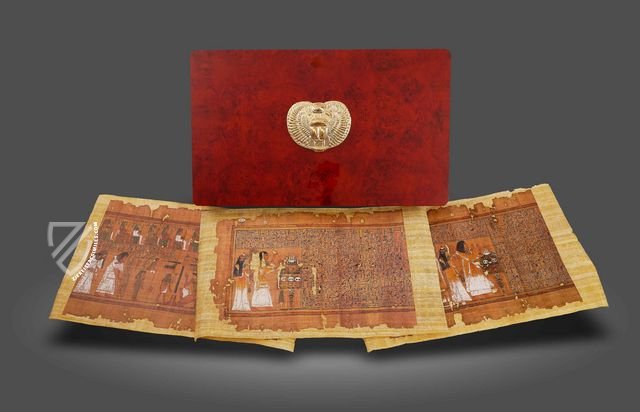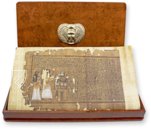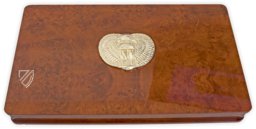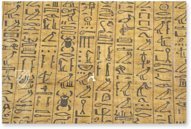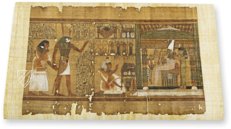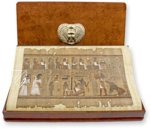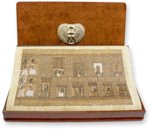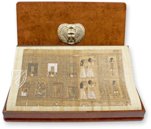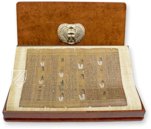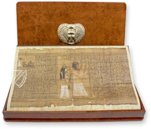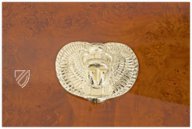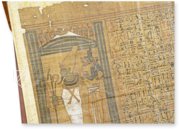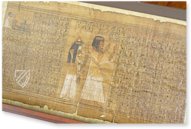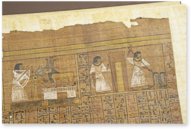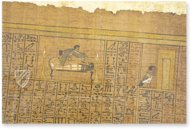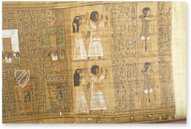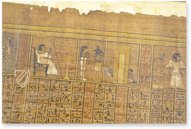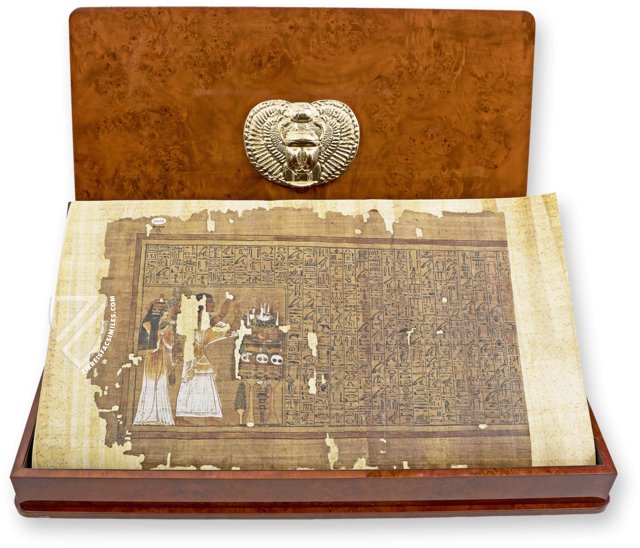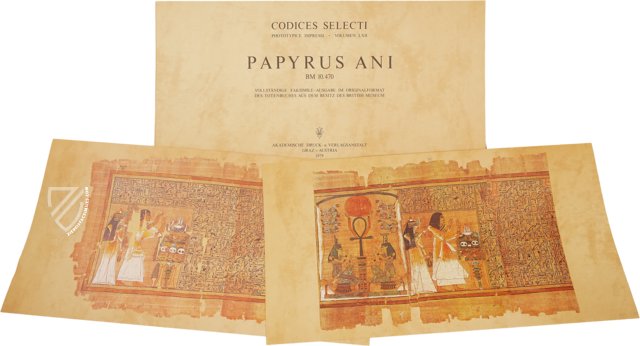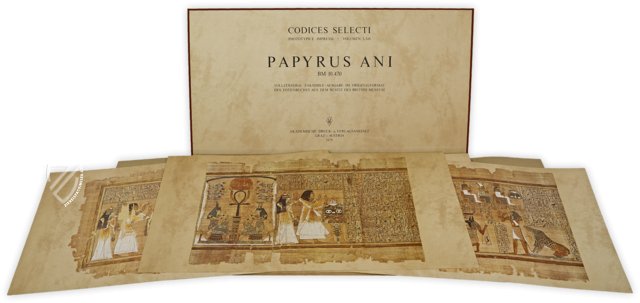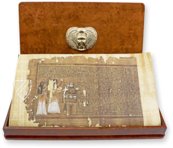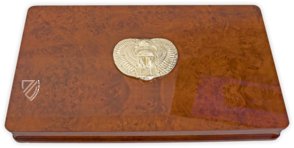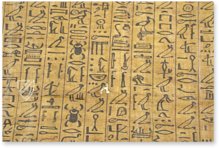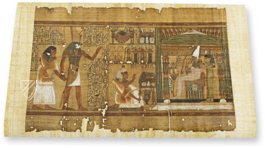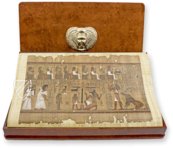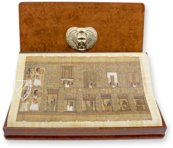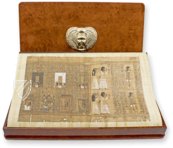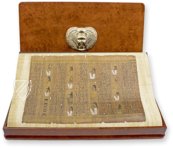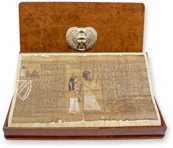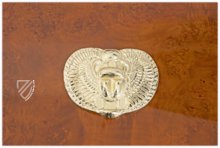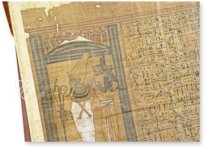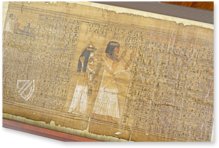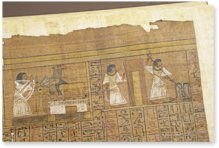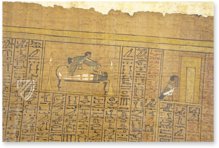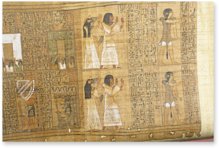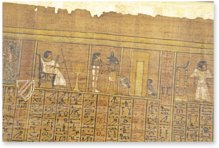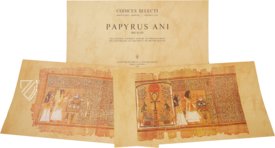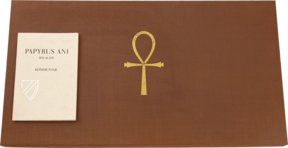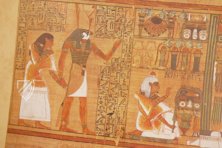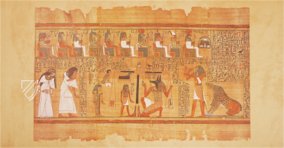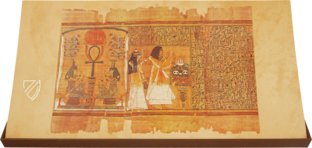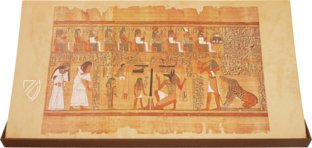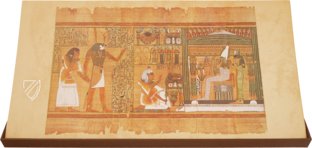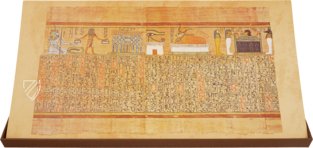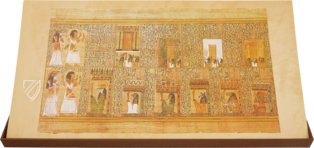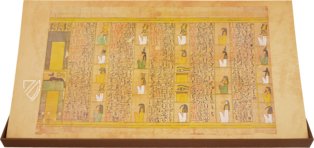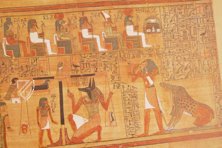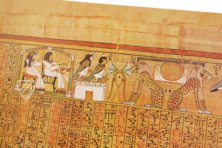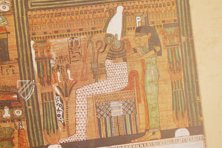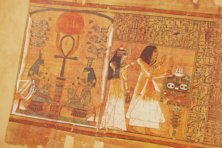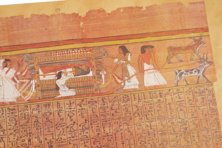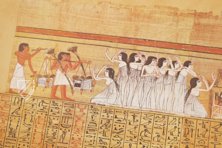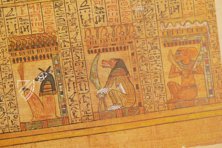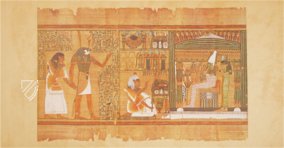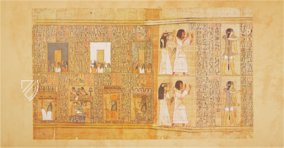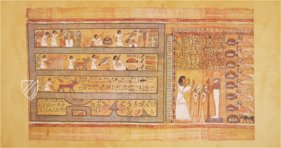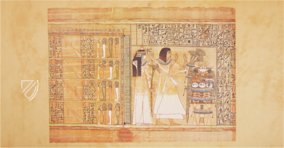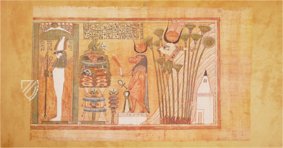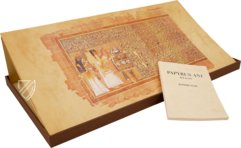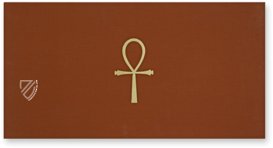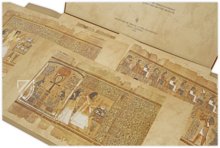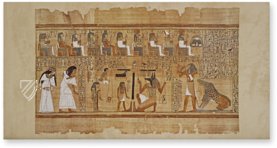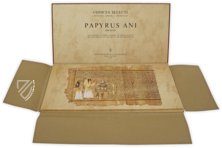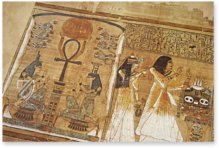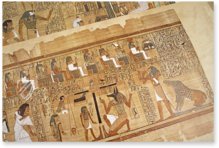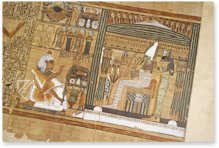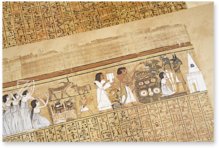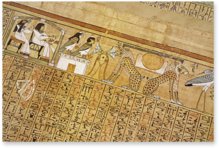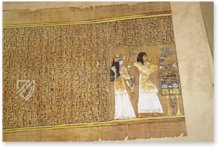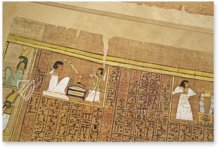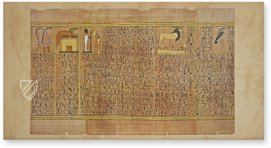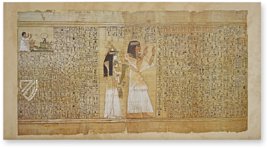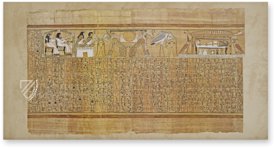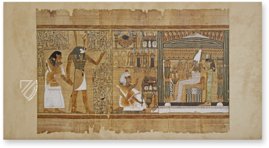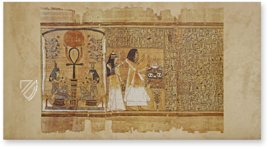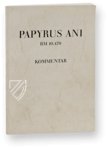Papyrus Ani
The Papyrus Ani is an exceptionally significant and insightful text of ancient Egyptian literature. The remarkably well-preserved book of the dead was found in Thebes and is dated to 1240 BC. To this day, only four unique copies of the work have survived, the ancient Egyptian title of which is actually ‘Sayings of Going Out by Day’. The papyrus presents about 190 magical formulas, religious texts and particularly large colourful illuminations visualising the content of the text over an impressive 24 metres. The manuscript is therefore a central source for the study of the mythology and death cult of ancient Egypt. While mummification guaranteed the integrity of the body and the tomb served as a house for eternity, the books of the dead were intended to provide the deceased with the necessary information about the afterlife. There, it was believed that the dead had to fend off various dangers, reach paradisiacal realms and finally ask to be accepted by the gods.
Papyrus Ani
An important text of ancient Egyptian literature was discovered in Thebes with the 24 meter long Papyrus Ani. Also known as the Egyptian Book of the Dead, the text is dated to 1,240 years before Christ and survives today in four specimens, each of which is unique. With its great selection of ca. 200 magical formulas and religious instructions, the fully preserved text is additionally a special document of Egyptian mythology that not only fascinates researchers today. Large colored drawings complement the views on death and the life thereafter with a particularly strong symbolic language.
Great Illustrations and Uniform Design
The book of the dead boasts a uniform design across its entire length, characterized by red and yellow stripes on the upper and lower margins. The text found in between is structured by red-marked titles of the individual chapters, rubrics, and various keywords. Based upon the various fonts, researchers have concluded that three to four scribes worked on the Papyrus Ani. Since the illustrations are much more uniform in their form of presentation, there were probably only one or two artists contributing to the paintings. The stiff deportment of the figures depicted in bas-relief are typical for ancient Egyptian art. Invariably, the head is depicted from the side with one eye, the shoulders and chest from the front, and the hip and leg from the side once again. This stylistic element called aspective endeavored to capture people as completely as possible.
Egyptian Mythology and Death
Magic spells and incantations, like those found in the book of the dead, already existed during the 5th/6th dynasty ca. 2500 B.C. Many of them were intended to help the dead to become divine and to make it possible to lead a life in the next world where they were immortal. In order to reach this goal and to be protected from demons on the way there, the Egyptians gave the deceased sayings as protection and help during the journey. Moreover, the text chronicles 43 various gods in the court of the dead altogether. Each has their own name and was responsible for a particular crime.
Ani as a Historical Figure
Ani was probably a high-ranking official of the temple administration since the book of the dead can be considered typical for a Theban nobleman of his period. Multiple places in the text where his name was inserted by a later hand indicate that the text was not originally composed for Ani. Such addenda are not, however, found in the first part, which was probably consequently finished expressly for him.
Codicology
- Alternative Titles
- Papyrus of Ani
El Libro de los muertos
Book of the Death
Papiro de Ani - Size / Format
- 37 segments / 38.0 × 70.0 cm
- Origin
- Egypt
- Date
- 1240 BCE
- Epochs
- Style
- Language
- Script
- Egyptian Hieroglyphs
- Illustrations
- Several large, coloured drawings
- Content
- Egyptian Book of the Dead
- Patron
- Ani, a high ranking officer of the temple administration
- Artist / School
- 3-4 scribes and 1-2 painters
Papyrus Ani
Presentation of Ani before Osiris
This scene shows Ani kneeling before Osiris, god of the afterlife and judge of the dead, whom is identifiable by his characteristic crook and flail as well as his distinctive “atef” crown. His sisters Isis and Nephthys stand behind Osiris with their hands on his shoulders, and in front of his throne there is a lotus on which stand the four sons of Horus. The throne of Osiris sits in a splendid baldachin decorated with various hieroglyphics and patterns. Ani has his hand raised in explanation.
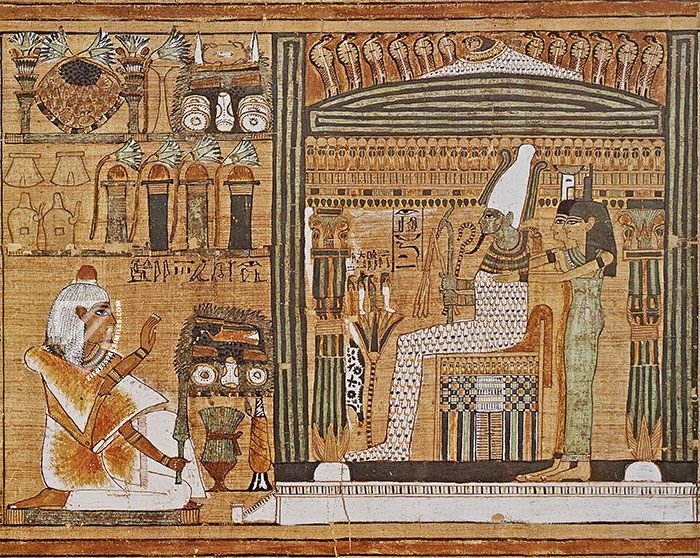
Papyrus Ani
Thoth's Declaration to the Ennead
This 3,200-year-old miniature is exemplary of both the attitude towards death held by ancient Egyptians and of the aesthetic of Egyptian papyri. Toth, an Egyptian deity associated with judging the dead, weighs the heart of the scribe Ani against a feather. He declares his findings to the Ennead, a group of nine deities including Atum, Osiris, Isis, and Seth.
This composition of red, green, and white is the work of one or possibly two artists. The figures are depicted with a stiff deportment in the strict bas-relief typical of Egyptian art, the so-called “aspective” that captures people as completely as possible. Heads are depicted in profile with one eye showing, chests and shoulders point toward the beholder, with the hip and leg depicted from the side.
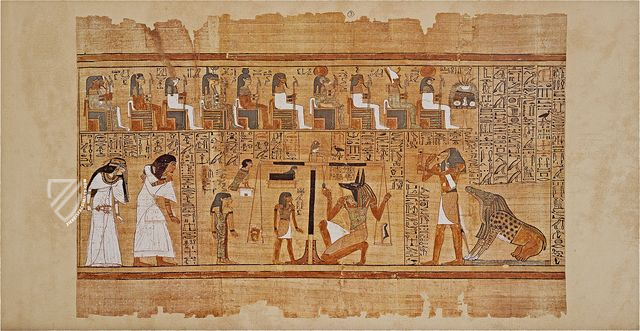
#1 El Libro de los muertos (Papiro de Ani)
Language: Spanish
#2 Der Papyrus Ani - Special Edition
Language: German
(1,000€ - 3,000€)
#3 Der Papyrus Ani - Standard Edition
Language: German
(1,000€ - 3,000€)
- Treatises / Secular Books
- Apocalypses / Beatus
- Astronomy / Astrology
- Bestiaries
- Bibles / Gospels
- Chronicles / History / Law
- Geography / Maps
- Saints' Lives
- Islam / Oriental
- Judaism / Hebrew
- Single Leaf Collections
- Leonardo da Vinci
- Literature / Poetry
- Liturgical Manuscripts
- Medicine / Botany / Alchemy
- Music
- Mythology / Prophecies
- Psalters
- Other Religious Books
- Games / Hunting
- Private Devotion Books
- Other Genres
- Afghanistan
- Armenia
- Austria
- Belgium
- Belize
- Bosnia and Herzegovina
- China
- Colombia
- Costa Rica
- Croatia
- Cyprus
- Czech Republic
- Denmark
- Egypt
- El Salvador
- Ethiopia
- France
- Germany
- Greece
- Guatemala
- Honduras
- Hungary
- India
- Iran
- Iraq
- Israel
- Italy
- Japan
- Jordan
- Kazakhstan
- Kyrgyzstan
- Lebanon
- Liechtenstein
- Luxembourg
- Mexico
- Morocco
- Netherlands
- Palestine
- Panama
- Peru
- Poland
- Portugal
- Romania
- Russia
- Serbia
- Spain
- Sri Lanka
- Sweden
- Switzerland
- Syria
- Tajikistan
- Turkey
- Turkmenistan
- Ukraine
- United Kingdom
- United States
- Uzbekistan
- Vatican City
- A. Oosthoek, van Holkema & Warendorf
- Aboca Museum
- Ajuntament de Valencia
- Akademie Verlag
- Akademische Druck- u. Verlagsanstalt (ADEVA)
- Aldo Ausilio Editore - Bottega d’Erasmo
- Alecto Historical Editions
- Alkuin Verlag
- Almqvist & Wiksell
- Amilcare Pizzi
- Andreas & Andreas Verlagsbuchhandlung
- Archa 90
- Archiv Verlag
- Archivi Edizioni
- Arnold Verlag
- ARS
- Ars Magna
- ArtCodex
- AyN Ediciones
- Azimuth Editions
- Badenia Verlag
- Bärenreiter-Verlag
- Belser Verlag
- Belser Verlag / WK Wertkontor
- Benziger Verlag
- Bernardinum Wydawnictwo
- BiblioGemma
- Biblioteca Apostolica Vaticana (Vaticanstadt, Vaticanstadt)
- Bibliotheca Palatina Faksimile Verlag
- Bibliotheca Rara
- Boydell & Brewer
- Bramante Edizioni
- Bredius Genootschap
- Brepols Publishers
- British Library
- C. Weckesser
- Caixa Catalunya
- Canesi
- CAPSA, Ars Scriptoria
- Caratzas Brothers, Publishers
- Carus Verlag
- Casamassima Libri
- Centrum Cartographie Verlag GmbH
- Chavane Verlag
- Christian Brandstätter Verlag
- Circulo Cientifico
- Club Bibliófilo Versol
- Club du Livre
- CM Editores
- Collegium Graphicum
- Collezione Apocrifa Da Vinci
- Comissão Nacional para as Comemorações dos Descobrimentos Portugueses
- Coron Verlag
- Corvina
- CTHS
- D. S. Brewer
- Damon
- De Agostini/UTET
- De Nederlandsche Boekhandel
- De Schutter
- Deuschle & Stemmle
- Deutscher Verlag für Kunstwissenschaft
- DIAMM
- Droz
- E. Schreiber Graphische Kunstanstalten
- Ediciones Boreal
- Ediciones Grial
- Ediclube
- Edições Inapa
- Edilan
- Editalia
- Edition Deuschle
- Edition Georg Popp
- Edition Leipzig
- Edition Libri Illustri
- Editiones Reales Sitios S. L.
- Éditions de l'Oiseau Lyre
- Editions Medicina Rara
- Editorial Casariego
- Editorial Mintzoa
- Editrice Antenore
- Editrice Velar
- Edizioni Edison
- Egeria, S.L.
- Eikon Editores
- Electa
- Emery Walker Limited
- Enciclopèdia Catalana
- Eos-Verlag
- Ephesus Publishing
- Ernst Battenberg
- Eugrammia Press
- Extraordinary Editions
- Fackelverlag
- Facsimila Art & Edition
- Facsimile Editions Ltd.
- Facsimilia Art & Edition Ebert KG
- Faksimile Verlag
- Feuermann Verlag
- Folger Shakespeare Library
- Franco Cosimo Panini Editore
- Friedrich Wittig Verlag
- Fundación Hullera Vasco-Leonesa
- G. Braziller
- Gabriele Mazzotta Editore
- Gebr. Mann Verlag
- Gesellschaft für graphische Industrie
- Getty Research Institute
- Giovanni Domenico de Rossi
- Giunti Editore
- Graffiti
- Grafica European Center of Fine Arts
- Guido Pressler
- Guillermo Blazquez
- Gustav Kiepenheuer
- H. N. Abrams
- Harrassowitz
- Harvard University Press
- Helikon
- Hendrickson Publishers
- Henning Oppermann
- Herder Verlag
- Hes & De Graaf Publishers
- Hoepli
- Holbein-Verlag
- Houghton Library
- Hugo Schmidt Verlag
- Idion Verlag
- Il Bulino, edizioni d'arte
- ILte
- Imago
- Insel Verlag
- Insel-Verlag Anton Kippenberger
- Instituto de Estudios Altoaragoneses
- Instituto Nacional de Antropología e Historia
- Introligatornia Budnik Jerzy
- Istituto dell'Enciclopedia Italiana - Treccani
- Istituto Ellenico di Studi Bizantini e Postbizantini
- Istituto Geografico De Agostini
- Istituto Poligrafico e Zecca dello Stato
- Italarte Art Establishments
- Jan Thorbecke Verlag
- Johnson Reprint Corporation
- Josef Stocker
- Josef Stocker-Schmid
- Jugoslavija
- Karl W. Hiersemann
- Kasper Straube
- Kaydeda Ediciones
- Kindler Verlag / Coron Verlag
- Kodansha International Ltd.
- Konrad Kölbl Verlag
- Kurt Wolff Verlag
- La Liberia dello Stato
- La Linea Editrice
- La Meta Editore
- Lambert Schneider
- Landeskreditbank Baden-Württemberg
- Leo S. Olschki
- Les Incunables
- Liber Artis
- Library of Congress
- Libreria Musicale Italiana
- Lichtdruck
- Lito Immagine Editore
- Lumen Artis
- Lund Humphries
- M. Moleiro Editor
- Maison des Sciences de l'homme et de la société de Poitiers
- Manuscriptum
- Martinus Nijhoff
- Maruzen-Yushodo Co. Ltd.
- MASA
- Massada Publishers
- McGraw-Hill
- Metropolitan Museum of Art
- Militos
- Millennium Liber
- Müller & Schindler
- Nahar - Stavit
- Nahar and Steimatzky
- National Library of Wales
- Neri Pozza
- Nova Charta
- Oceanum Verlag
- Odeon
- Orbis Mediaevalis
- Orbis Pictus
- Österreichische Staatsdruckerei
- Oxford University Press
- Pageant Books
- Parzellers Buchverlag
- Patrimonio Ediciones
- Pattloch Verlag
- PIAF
- Pieper Verlag
- Plon-Nourrit et cie
- Poligrafiche Bolis
- Presses Universitaires de Strasbourg
- Prestel Verlag
- Princeton University Press
- Prisma Verlag
- Priuli & Verlucca, editori
- Pro Sport Verlag
- Propyläen Verlag
- Pytheas Books
- Quaternio Verlag Luzern
- Reales Sitios
- Recht-Verlag
- Reichert Verlag
- Reichsdruckerei
- Reprint Verlag
- Riehn & Reusch
- Roberto Vattori Editore
- Rosenkilde and Bagger
- Roxburghe Club
- Salerno Editrice
- Saltellus Press
- Sandoz
- Sarajevo Svjetlost
- Schöck ArtPrint Kft.
- Schulsinger Brothers
- Scolar Press
- Scrinium
- Scripta Maneant
- Scriptorium
- Shazar
- Siloé, arte y bibliofilia
- SISMEL - Edizioni del Galluzzo
- Sociedad Mexicana de Antropología
- Société des Bibliophiles & Iconophiles de Belgique
- Soncin Publishing
- Sorli Ediciones
- Stainer and Bell
- Studer
- Styria Verlag
- Sumptibus Pragopress
- Szegedi Tudomànyegyetem
- Taberna Libraria
- Tarshish Books
- Taschen
- Tempus Libri
- Testimonio Compañía Editorial
- Thames and Hudson
- The Clear Vue Publishing Partnership Limited
- The Facsimile Codex
- The Folio Society
- The Marquess of Normanby
- The Richard III and Yorkist History Trust
- Tip.Le.Co
- TouchArt
- TREC Publishing House
- TRI Publishing Co.
- Trident Editore
- Tuliba Collection
- Typis Regiae Officinae Polygraphicae
- Union Verlag Berlin
- Universidad de Granada
- University of California Press
- University of Chicago Press
- Urs Graf
- Vallecchi
- Van Wijnen
- VCH, Acta Humaniora
- VDI Verlag
- VEB Deutscher Verlag für Musik
- Verlag Anton Pustet / Andreas Verlag
- Verlag Bibliophile Drucke Josef Stocker
- Verlag der Münchner Drucke
- Verlag für Regionalgeschichte
- Verlag Styria
- Vicent Garcia Editores
- W. Turnowski Ltd.
- W. Turnowsky
- Waanders Printers
- Wiener Mechitharisten-Congregation (Wien, Österreich)
- Wissenschaftliche Buchgesellschaft
- Wissenschaftliche Verlagsgesellschaft
- Wydawnictwo Dolnoslaskie
- Xuntanza Editorial
- Zakład Narodowy
- Zollikofer AG

